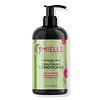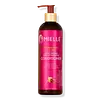What's inside
What's inside
 Benefits
Benefits

 Concerns
Concerns

 Ingredients Side-by-side
Ingredients Side-by-side

Water
Skin ConditioningCetearyl Alcohol
EmollientPolyquaternium-7
Caprylic/Capric Triglyceride
MaskingBehentrimonium Chloride
PreservativeC12-15 Alkyl Benzoate
AntimicrobialParfum
MaskingPersea Gratissima Oil
Skin ConditioningPPG-3 Myristyl Ether
EmollientBiotin
AntiseborrhoeicButyrospermum Parkii Butter
Skin ConditioningCocos Nucifera Oil
MaskingRosmarinus Officinalis Leaf Oil
MaskingMentha Piperita Oil
MaskingOlea Europaea Fruit Oil
MaskingPanthenol
Skin ConditioningBehentrimonium Methosulfate
Diheptyl Succinate
EmollientCapryloyl Glycerin/Sebacic Acid Copolymer
Skin ConditioningCetyl Alcohol
EmollientWater, Cetearyl Alcohol, Polyquaternium-7, Caprylic/Capric Triglyceride, Behentrimonium Chloride, C12-15 Alkyl Benzoate, Parfum, Persea Gratissima Oil, PPG-3 Myristyl Ether, Biotin, Butyrospermum Parkii Butter, Cocos Nucifera Oil, Rosmarinus Officinalis Leaf Oil, Mentha Piperita Oil, Olea Europaea Fruit Oil, Panthenol, Behentrimonium Methosulfate, Diheptyl Succinate, Capryloyl Glycerin/Sebacic Acid Copolymer, Cetyl Alcohol
Water
Skin ConditioningPrunus Amygdalus Dulcis Oil
Skin ConditioningCyclopentasiloxane
EmollientCetearyl Alcohol
EmollientBehentrimonium Methosulfate
Cocos Nucifera Oil
MaskingStearalkonium Chloride
PreservativeParfum
MaskingHoney
HumectantGlycerin
HumectantEuterpe Oleracea Fruit Extract
Punica Granatum Seed Oil
EmollientOrbignya Oleifera Seed Oil
EmollientMauritia Flexuosa Fruit Oil
Skin ConditioningCopaifera Officinalis Resin
MaskingAstrocaryum Murumuru Seed Butter
EmollientDisodium EDTA
DMDM Hydantoin
PreservativeAminomethyl Propanol
BufferingPhenoxyethanol
PreservativeBenzoic Acid
MaskingEthylhexylglycerin
Skin ConditioningGlycereth-2 Cocoate
EmulsifyingWater, Prunus Amygdalus Dulcis Oil, Cyclopentasiloxane, Cetearyl Alcohol, Behentrimonium Methosulfate, Cocos Nucifera Oil, Stearalkonium Chloride, Parfum, Honey, Glycerin, Euterpe Oleracea Fruit Extract, Punica Granatum Seed Oil, Orbignya Oleifera Seed Oil, Mauritia Flexuosa Fruit Oil, Copaifera Officinalis Resin, Astrocaryum Murumuru Seed Butter, Disodium EDTA, DMDM Hydantoin, Aminomethyl Propanol, Phenoxyethanol, Benzoic Acid, Ethylhexylglycerin, Glycereth-2 Cocoate
Ingredients Explained
These ingredients are found in both products.
Ingredients higher up in an ingredient list are typically present in a larger amount.
Behentrimonium Methosulfate is an ammonium salt. It is mainly used to prevent static in haircare products as a surfactant.
Surfactants have differing ends: one side is hydrophilic while the other end is hydrophobic.
Surfactants also help your cleansers remove pollutants more easily from the skin.
Learn more about Behentrimonium MethosulfateCetearyl alcohol is a mixture of two fatty alcohols: cetyl alcohol and stearyl alcohol. It is mainly used as an emulsifier. Emulsifiers help prevent the separation of oils and products. Due to its composition, it can also be used to thicken a product or help create foam.
Cetearyl alcohol is an emollient. Emollients help soothe and hydrate the skin by trapping moisture.
Studies show Cetearyl alcohol is non-toxic and non-irritating. The FDA allows products labeled "alcohol-free" to have fatty alcohols.
This ingredient is usually derived from plant oils such as palm, vegetable, or coconut oils. There is debate on whether this ingredient will cause acne.
Due to the fatty acid base, this ingredient may not be Malassezia folliculitis safe.
Learn more about Cetearyl AlcoholCocos Nucifera Oil is obtained from the kernels of the coconut fruit. In other words, this is coconut oil.
Coconut Oil is rich in fatty acids with lauric acid making up the majority of these. It also contains linoleic acid. Due to this high fatty acid content, coconut oil helps trap moisture and soften skin.
Despite being antibacterial, coconut oil may not be great for acne-prone skin. It is comedogenic and may clog pores. This ingredient may not be safe for malassezia or fungal acne.
Note: Coconut Oil should not replace your sunscreen for UV protection. Studies show it only blocks about 20% of UV.
This oil is non-volatile and has a light scent.
The term 'fragrance' is not regulated in many countries. In many cases, it is up to the brand to define this term. For instance, many brands choose to label themselves as "fragrance-free" because they are not using synthetic fragrances. However, their products may still contain ingredients such as essential oils that are considered a fragrance.
Learn more about Cocos Nucifera OilParfum is a catch-all term for an ingredient or more that is used to give a scent to products.
Also called "fragrance", this ingredient can be a blend of hundreds of chemicals or plant oils. This means every product with "fragrance" or "parfum" in the ingredients list is a different mixture.
For instance, Habanolide is a proprietary trade name for a specific aroma chemical. When used as a fragrance ingredient in cosmetics, most aroma chemicals fall under the broad labeling category of “FRAGRANCE” or “PARFUM” according to EU and US regulations.
The term 'parfum' or 'fragrance' is not regulated in many countries. In many cases, it is up to the brand to define this term.
For instance, many brands choose to label themselves as "fragrance-free" because they are not using synthetic fragrances. However, their products may still contain ingredients such as essential oils that are considered a fragrance by INCI standards.
One example is Calendula flower extract. Calendula is an essential oil that still imparts a scent or 'fragrance'.
Depending on the blend, the ingredients in the mixture can cause allergies and sensitivities on the skin. Some ingredients that are known EU allergens include linalool and citronellol.
Parfum can also be used to mask or cover an unpleasant scent.
The bottom line is: not all fragrances/parfum/ingredients are created equally. If you are worried about fragrances, we recommend taking a closer look at an ingredient. And of course, we always recommend speaking with a professional.
Learn more about ParfumWater. It's the most common cosmetic ingredient of all. You'll usually see it at the top of ingredient lists, meaning that it makes up the largest part of the product.
So why is it so popular? Water most often acts as a solvent - this means that it helps dissolve other ingredients into the formulation.
You'll also recognize water as that liquid we all need to stay alive. If you see this, drink a glass of water. Stay hydrated!
Learn more about Water